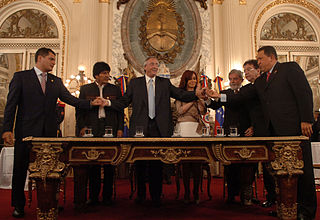Don’t bank on it: Chavez’s Banco del Sur; a BRICS bank

Rafael Correa, Evo Morales, Néstor Kirchner, Cristina Fernández,Luiz Inacio Lula Da Silva, Nicanor Duarte, and Hugo Chávez at the signing of the founding charter of the Bank of the South
The words ‘Bank of the South’ come to mind as one reads Foreign Policy on the great emerging markets’ grand plan for a BRICS bank.
As FP reports, Brazil, Russia, India, China and South Africa (BRICS) expressed the desire to start their own development bank as an alternative to the World Bank, but there are at least 10 questions that need to be answered before it can be a believable proposition.
– Is it a done deal?
– Do the BRICS have enough in common to sustain a shared institution?
– What will the new development bank focus on?
– Will developing countries welcome the BRICS development bank?
– Will the Bank be dominated by China?
– How will the bank be capitalized?
– What currency will the new bank use?
– Aren’t the BRICS “doing development” already?
– Do the BRICS already invest in each other?
– Will a new development bank pose a challenge to the World Bank?
At least half of those questions could be asked of the Bank of the South, that grand idea dreamt up by the late Hugo Chavez as real South American liberation from ‘IMF and WB hegemony’ and prescriptive free market reform.
So to the five questions that remain unanswered on the Banco del Sur:
1. First, is it a done deal?
Not exactly. The Bank, first materialized on the world stage as a concept back in 1998, during Chavez’s first presidential campaign. It took eight years to get Argentina to commit to it and it was only in April 2007 that Brazil signed up too. The Bank was officially created the very next month but it is still not fully operational and there’s a start month on it (April 2013) but not a start date.
2. How will it be capitalized?
That is the 20-billion-dollar question. In September 2009, the presidents of Argentina, Brazil, Paraguay, Uruguay, Ecuador, Bolivia and Venezuela agreed it would have an initial capital of $20 billion. But it remained unclear how much each country would contribute and LatAm experts say it won’t get off the ground if the Venezuelans don’t stump up enough (which they might not, if they don’t have the money).
3. Isn’t South America “doing development” already?
Yes, especially through the 18-member Corporación Andina de Fomento, or the Latin American Development Bank, headquartered in Caracas. It’s said to now provide more funding to Latin America than the World Bank and the Inter-American Development Bank combined, at least partly because it doesn’t require quite so many boxes to be ticked with respect to the environmental impact of a project.
4. Do South American countries already invest in one another?
Yes, up to a point. But there’s room, as Chavez rightly pointed out for more regional dependence and more endogenous development.
5. Does the Bank of the South pose a challenge to the World Bank?
Yes, and so it should. If it got going properly. The Nobel Prize-winning former WB economist Joseph Stiglitz is on record to say that a regional developmental bank like the Banco del Sur is a good idea because “it would reflect the perspectives of those in the south.” He added, for good measure, that “it is a good thing to have competition in most markets, including the market for development lending”.
A BRICS bank too, could be a force for good. If it ever got going. And stayed at it.
But like the Bank of the South, there’s a very long way still to go.

